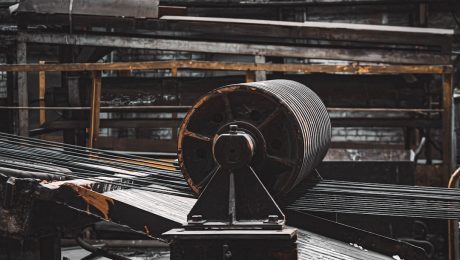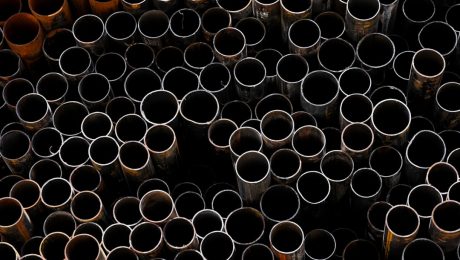The steel industry is a behemoth, demanding efficient and cost-effective logistics to move massive quantities of material across vast distances. Optimizing steel delivery is no longer a luxury; it’s a necessity for survival in a competitive market. This post delves into the key strategies and technologies that are transforming steel logistics, from initial planning to final delivery.
1. Route Optimization: The Steel Mile’s Smartest Path
Route optimization is paramount in steel delivery. Traditional methods often rely on simple, often outdated, routes, leading to increased fuel consumption, extended delivery times, and higher transportation costs. Advanced route planning software utilizes sophisticated algorithms considering factors like traffic patterns, road conditions, weight restrictions, and delivery windows. These systems analyze vast datasets to identify the most efficient routes, minimizing mileage and transit time. Furthermore, real-time tracking capabilities allow for dynamic route adjustments based on unforeseen events like accidents or traffic congestion, ensuring timely delivery even in unpredictable circumstances. Implementing a robust route optimization system can significantly reduce fuel costs, decrease delivery times, and improve overall operational efficiency. The integration of GPS tracking and telematics further enhances this process, providing real-time visibility into the location and status of each shipment.
2. Inventory Management: Precision in Steel Stock Control
Effective inventory management is crucial for preventing stockouts and minimizing storage costs in the steel industry. Precise forecasting models, coupled with real-time inventory tracking systems, enable companies to anticipate demand accurately. This prevents overstocking, which ties up capital and increases storage expenses, and understocking, which leads to lost sales and production delays. Advanced inventory management systems can integrate with transportation management systems (TMS) to optimize delivery schedules based on current stock levels and anticipated demand. This coordination ensures that steel is delivered just-in-time (JIT), minimizing warehousing costs and reducing the risk of obsolescence or damage to materials. Furthermore, implementing barcode or RFID tracking allows for precise inventory counts and real-time updates, improving accuracy and reducing manual errors.
3. Transportation Management Systems (TMS): Orchestrating the Steel Symphony
A robust TMS is the conductor of the steel delivery orchestra. It consolidates all aspects of transportation planning and execution into a single platform. This includes route optimization, carrier selection, load planning, document management, and shipment tracking. A TMS allows companies to manage multiple carriers, negotiate favorable rates, and track shipments in real-time. The centralized view provided by a TMS enhances visibility across the entire supply chain, enabling proactive problem-solving and improved decision-making. By automating many manual processes, a TMS also frees up valuable time and resources for strategic planning and other high-value tasks. Furthermore, the data collected by a TMS can be used to identify areas for improvement and optimize the entire logistics process continuously.
4. Leveraging Technology: Data Analytics and Predictive Modeling
Data analytics and predictive modeling are transforming steel delivery logistics. By analyzing historical data on delivery times, fuel consumption, and other relevant metrics, companies can identify trends and patterns that reveal areas for improvement. Predictive modeling can forecast future demand, optimize inventory levels, and anticipate potential disruptions in the supply chain. This allows for proactive adjustments to prevent delays and minimize costs. Machine learning algorithms can analyze vast datasets to identify optimal routes, predict potential delays, and optimize resource allocation. The insights gained from data analytics and predictive modeling empower steel companies to make data-driven decisions, leading to significant improvements in efficiency and profitability.
5. Collaboration and Communication: The Foundation of Optimized Steel Delivery
Effective communication and collaboration among all stakeholders are critical for successful steel delivery optimization. This includes seamless information sharing between suppliers, manufacturers, transporters, and customers. Utilizing collaborative platforms and communication tools ensures timely updates on shipment status, potential delays, and any other relevant information. A well-defined communication protocol ensures that everyone is on the same page, minimizing confusion and preventing delays. This collaborative approach fosters a more transparent and efficient supply chain, leading to improved customer satisfaction and reduced operational costs. Real-time communication tools, such as mobile apps and messaging platforms, further enhance collaboration and allow for quick responses to unforeseen circumstances.
By implementing these strategies and leveraging the power of technology, steel companies can forge a more efficient and profitable future. Optimizing steel delivery isn’t just about reducing costs; it’s about improving customer satisfaction, enhancing operational efficiency, and gaining a competitive edge in a demanding market.
SEO-Friendly Tags:
- Steel Delivery Optimization
- Logistics in Steel Industry
- Route Optimization for Steel
- Steel Supply Chain Management
- Transportation Management Steel
The steel industry, a cornerstone of global infrastructure and manufacturing, faces unique challenges in managing its intricate supply chain. From the extraction of raw materials to the delivery of finished products, the process is complex, demanding, and heavily influenced by global market fluctuations. Effective supply chain management (SCM) is not merely a cost-saving measure; it’s the lifeblood of a steel company’s success, influencing profitability, competitiveness, and sustainability.
1. Securing the Source: Raw Material Procurement and Management
The foundation of any steel supply chain lies in the secure and efficient procurement of raw materials. This primarily involves iron ore, coal, and limestone, all of which are subject to price volatility and geopolitical factors. Effective SCM requires strategic sourcing, establishing long-term contracts with reliable suppliers to mitigate price risks. Diversification of sourcing locations is crucial to reduce dependency on single suppliers and navigate potential disruptions caused by natural disasters, political instability, or supply chain bottlenecks. Furthermore, companies are increasingly focusing on sustainable sourcing, prioritizing suppliers committed to environmentally responsible mining practices and reducing their carbon footprint. This includes implementing robust due diligence processes to ensure ethical sourcing and compliance with environmental regulations.
2. Optimizing the Furnace: Production Planning and Inventory Control
Steel production is an energy-intensive process, demanding precise planning and efficient inventory management. Effective SCM necessitates accurate forecasting of demand to optimize production schedules, minimizing waste and maximizing output. This involves sophisticated planning software that integrates real-time data on orders, inventory levels, and production capacity. Just-in-time (JIT) inventory management strategies are commonly employed to reduce storage costs and minimize waste, but require precise coordination between production and delivery schedules. Furthermore, advanced analytics are increasingly used to predict potential production bottlenecks and optimize resource allocation, leading to improved efficiency and reduced lead times.
3. Navigating the Network: Logistics and Transportation Management
The steel industry relies heavily on efficient and cost-effective transportation networks. Steel products are bulky and heavy, requiring specialized transportation methods such as rail, sea freight, and trucking. Effective SCM in this area involves optimizing transportation routes, selecting appropriate modes of transport based on cost and delivery time requirements, and managing logistics partnerships with reliable carriers. Real-time tracking and monitoring of shipments is essential to ensure timely delivery and minimize disruptions. Furthermore, the increasing focus on sustainability is driving the adoption of greener transportation solutions, such as electric vehicles and alternative fuels, to reduce the environmental impact of steel logistics.
4. Managing the Flow: Inventory Management and Warehouse Optimization
Efficient inventory management is critical for minimizing storage costs, preventing stockouts, and ensuring timely delivery of steel products. This involves implementing robust inventory tracking systems, utilizing advanced forecasting techniques to predict demand fluctuations, and optimizing warehouse layout and operations to maximize storage capacity and efficiency. Effective warehouse management systems (WMS) play a crucial role in managing inventory levels, tracking product movement, and optimizing picking and packing processes. Furthermore, the integration of WMS with other SCM systems, such as ERP (Enterprise Resource Planning) and TMS (Transportation Management Systems), ensures seamless data flow and improved decision-making.
5. Forging Resilience: Risk Management and Supply Chain Disruptions
The steel industry is susceptible to various risks, including price volatility of raw materials, geopolitical instability, natural disasters, and unforeseen disruptions in the supply chain. Effective SCM necessitates a proactive approach to risk management, involving identifying potential disruptions, assessing their impact, and developing contingency plans to mitigate their effects. This includes diversifying suppliers, establishing backup supply sources, and building strategic partnerships with key stakeholders. Furthermore, robust risk monitoring systems are crucial for detecting early warning signs of potential disruptions and enabling timely interventions. Investing in technology such as blockchain technology can enhance transparency and traceability throughout the supply chain, improving resilience and facilitating faster responses to disruptions.
In conclusion, successful supply chain management is paramount for the steel industry’s continued growth and profitability. By strategically addressing each stage of the supply chain, from raw material sourcing to final product delivery, steel companies can enhance efficiency, reduce costs, improve sustainability, and build a resilient and competitive business.
SEO Tags:
- Steel Supply Chain Management
- Steel Industry Logistics
- Steel Production Optimization
- Raw Material Procurement Steel
- Supply Chain Risk Management Steel
In industries ranging from aerospace and automotive to robotics and medical devices, the reliability of connections is paramount. Traditional connection methods often fail under shock and vibration, leading to malfunctions, downtime, and even catastrophic failures. This is where shock-resistant connection systems step in, offering robust and dependable solutions for maintaining connectivity in even the most demanding environments. This comprehensive guide delves into the intricacies of these vital systems.
Understanding the Need for Shock-Resistant Connections
Shock and vibration are ubiquitous in many applications. From the jarring impacts experienced during transportation to the constant micro-vibrations of machinery, these forces can put immense stress on connections. Loose connections lead to signal loss, power interruptions, and mechanical failures. The consequences can range from minor inconveniences to significant safety hazards and costly repairs. Shock-resistant connection systems are designed to mitigate these risks by providing a secure and stable connection that can withstand significant mechanical stress.
The severity of the shock and vibration dictates the type of connection system required. For example, a system designed for a delicate medical instrument will have different requirements than one used in a heavy-duty industrial setting. Factors such as frequency, amplitude, and duration of the shock must all be considered when selecting an appropriate system.
Types of Shock-Resistant Connection Systems
Several different types of shock-resistant connection systems exist, each with its own strengths and weaknesses. These include:
- Positive Locking Connectors: These connectors utilize mechanical features, such as bayonet mounts, threaded couplings, or latching mechanisms, to ensure a secure and reliable connection that resists disengagement under shock and vibration. They are commonly used in applications requiring high reliability and resistance to accidental disconnection.
- Vibration-Dampening Connectors: These systems incorporate materials or designs that absorb and dissipate vibrational energy, protecting the connection from the damaging effects of continuous vibration. Elastomeric materials, for example, are often used to create a compliant interface that reduces the transmission of vibrations.
- Redundant Connection Systems: These systems employ multiple connection points or pathways to ensure that even if one connection fails, the system remains operational. This is particularly critical in safety-critical applications where a single point of failure could have devastating consequences.
- Self-Locking Connectors: These connectors utilize a mechanism that automatically locks into place once connected, preventing accidental disconnection even under significant stress. This is often achieved through the use of spring-loaded mechanisms or other self-locking features.
- Specialized Connectors for Harsh Environments: Specific connectors are designed to withstand extreme temperatures, pressures, or corrosive environments in addition to shock and vibration. These often incorporate specialized materials and robust sealing mechanisms.
Design Considerations for Shock-Resistant Connections
Designing effective shock-resistant connection systems requires careful consideration of several factors:
- Material Selection: The choice of materials is crucial. Materials must possess high strength, stiffness, and fatigue resistance to withstand repeated shock and vibration. Common materials include high-strength alloys, plastics with high impact resistance, and specialized elastomers.
- Connection Geometry: The geometry of the connection plays a vital role in its ability to withstand shock. Features like increased surface area, interlocking designs, and robust clamping mechanisms all contribute to improved shock resistance.
- Stress Analysis: Finite element analysis (FEA) is often used to simulate the behavior of the connection under various loading conditions. This allows engineers to optimize the design for maximum shock resistance and minimize stress concentrations.
- Environmental Factors: Environmental factors such as temperature, humidity, and corrosive substances can significantly affect the performance of the connection. These factors must be carefully considered during the design process.
- Testing and Validation: Rigorous testing is essential to verify the shock resistance of the connection system. This may involve subjecting the connection to various shock and vibration tests to ensure it meets the required performance specifications.
Applications of Shock-Resistant Connection Systems
The applications for shock-resistant connection systems are vast and diverse. They are critical components in numerous industries, including:
- Aerospace: Aircraft and spacecraft experience significant shock and vibration during launch, flight, and landing. Shock-resistant connections are essential for ensuring the reliable operation of critical systems.
- Automotive: Vehicles are subjected to significant vibrations and impacts during operation. Shock-resistant connections are used in various components, including engine mounts, suspension systems, and electronic control units.
- Robotics: Robots operate in dynamic environments and often experience significant shocks and vibrations. Robust connections are essential for ensuring the reliable operation of robotic arms, sensors, and actuators.
- Medical Devices: Medical devices, particularly implantable devices, require highly reliable connections that can withstand the stresses of the body’s movements.
- Industrial Machinery: Heavy industrial machinery is subjected to significant vibrations and impacts during operation. Shock-resistant connections are crucial for ensuring the safe and reliable operation of these machines.
Future Trends in Shock-Resistant Connection Systems
Ongoing research and development are constantly pushing the boundaries of shock-resistant connection technology. Future trends include:
- Smart Connectors: The integration of sensors and electronics into connectors allows for real-time monitoring of connection integrity and the detection of potential failures. This enables predictive maintenance and enhances system reliability.
- Advanced Materials: The development of new materials with enhanced strength, stiffness, and fatigue resistance will further improve the performance of shock-resistant connections.
- Miniaturization: The demand for smaller and more compact devices is driving the development of miniaturized shock-resistant connectors.
- Improved Reliability and Durability: Ongoing research aims to create even more reliable and durable connection systems that can withstand even more extreme conditions.
- Sustainable Designs: There is a growing emphasis on developing environmentally friendly connection systems using recycled or bio-based materials.
In conclusion, shock-resistant connection systems are critical components in numerous applications where reliable connectivity is paramount. Understanding their types, design considerations, and applications is essential for engineers and designers seeking to create robust and dependable systems capable of withstanding the rigors of harsh environments. The ongoing advancements in this field promise even more reliable and innovative solutions in the future.
Tags: Shock-resistant connectors, vibration dampening connectors, robust connections, connection systems, industrial connectors
Galvanized steel, a ubiquitous material in construction, infrastructure, and manufacturing, owes its widespread use to its exceptional corrosion resistance. This characteristic stems from a protective zinc coating that safeguards the underlying steel from the ravages of rust and degradation. But how effective is this protection, and what factors influence its longevity? This comprehensive guide delves into the intricacies of galvanized steel’s corrosion resistance, exploring its mechanisms, limitations, and diverse applications.
The Galvanization Process: A Protective Shield
The remarkable corrosion resistance of galvanized steel originates from the galvanization process itself. This process involves coating steel with a layer of zinc, typically through hot-dip galvanizing or electrogalvanizing. Hot-dip galvanizing immerses the steel in a molten zinc bath, resulting in a thick, durable zinc coating that adheres strongly to the steel surface. Electrogalvanizing, on the other hand, uses an electrolytic process to deposit a thinner zinc layer. Both methods create a barrier that prevents moisture and oxygen from reaching the steel, thereby inhibiting the oxidation process that leads to rust.
The thickness of the zinc coating is a crucial factor determining the longevity of the protection. Hot-dip galvanizing generally provides a thicker and more robust coating than electrogalvanizing, offering superior corrosion resistance, especially in harsh environments. The choice between these methods depends on the specific application and the desired level of protection.
The Sacrificial Anodic Protection: Beyond the Barrier
The corrosion resistance of galvanized steel isn’t solely reliant on the physical barrier provided by the zinc coating. Zinc is a more electrochemically active metal than steel, meaning it readily oxidizes (corrodes) before the steel. This phenomenon is known as sacrificial anodic protection. When exposed to moisture and oxygen, the zinc layer corrodes preferentially, creating a protective layer of zinc oxide and zinc carbonate. This sacrificial layer continues to protect the underlying steel even if the initial zinc coating is damaged, extending the lifespan of the galvanized steel.
This self-healing mechanism is a key advantage of galvanized steel. Small scratches or abrasions in the zinc coating don’t immediately compromise the entire structure’s integrity. The zinc continues to protect the exposed steel until the sacrificial layer is depleted.
Factors Affecting the Lifespan of Galvanized Steel
While galvanized steel offers excellent corrosion resistance, several factors can influence its lifespan and effectiveness. Environmental conditions play a significant role. Exposure to harsh marine environments, industrial pollutants, or acidic substances can accelerate corrosion. The thickness of the zinc coating is also critical; thicker coatings naturally offer longer-lasting protection. The quality of the galvanizing process itself is paramount; improper application can lead to defects that compromise the protective layer.
Furthermore, the type of steel used as a substrate can also impact the overall performance. The composition and surface finish of the steel can affect the adhesion of the zinc coating and its subsequent performance. Proper surface preparation before galvanization is essential to ensure optimal adhesion and corrosion resistance.
Applications Where Galvanized Steel Excels
The exceptional corrosion resistance of galvanized steel makes it ideal for a wide array of applications, particularly in outdoor and corrosive environments. It’s commonly used in construction for roofing, cladding, and structural components. In infrastructure projects, galvanized steel is used for bridges, guardrails, and fencing. The automotive industry utilizes it for body parts and chassis components. Other applications include pipelines, storage tanks, and various industrial equipment.
The versatility of galvanized steel is further enhanced by its ability to be easily fabricated and formed. It can be welded, cut, and shaped without significantly compromising its corrosion resistance, making it a highly practical and cost-effective material for numerous applications.
Maintaining the Integrity of Galvanized Steel
While galvanized steel is inherently durable, proper maintenance can significantly extend its lifespan. Regular cleaning can remove accumulated dirt, debris, and corrosive substances that might accelerate corrosion. Avoiding damage to the zinc coating is crucial; scratches and abrasions should be addressed promptly to prevent further corrosion. In severe environments, periodic inspections are recommended to identify and address any potential issues early on.
The choice of appropriate coatings or paints can also enhance the longevity of galvanized steel in specific applications. However, it’s essential to select coatings compatible with the zinc layer to avoid compromising its protective properties. Proper selection and application of coatings can further enhance the already impressive corrosion resistance of galvanized steel.
In conclusion, the superior corrosion resistance of galvanized steel is a result of both a physical barrier and a sacrificial anodic protection mechanism. Understanding the factors influencing its lifespan and proper maintenance practices can maximize the benefits of this versatile and durable material. Its widespread use across various industries underscores its importance as a reliable and cost-effective solution for numerous applications requiring exceptional resistance to corrosion.
Tags: galvanized steel, corrosion resistance, zinc coating, galvanization, steel protection
The relentless pursuit of renewable energy sources has propelled wind energy to the forefront of global power generation. Behind the majestic sweep of wind turbine blades lies a critical component often overlooked: steel profiles. These precisely engineered steel shapes are the unsung heroes, providing the structural integrity and strength necessary for these colossal structures to withstand the immense forces of nature. This comprehensive guide delves into the multifaceted role of steel profiles in wind energy projects.
1. The Tower’s Foundation: Steel Profiles in Wind Turbine Construction
The wind turbine tower, often reaching heights exceeding 100 meters, is a testament to engineering prowess. Steel profiles, primarily tubular sections and hollow sections, form the backbone of these towers. These profiles are chosen for their high strength-to-weight ratio, crucial for minimizing material costs and maximizing energy capture. Different grades of steel, such as high-strength low-alloy (HSLA) steels, are employed to withstand fatigue loading, bending moments, and torsional stresses caused by wind gusts and operational dynamics. The precise design of these profiles, including wall thickness and diameter, is meticulously calculated using sophisticated finite element analysis (FEA) software to ensure optimal performance and longevity in even the most extreme weather conditions. Connections between the different sections of the tower are equally critical, employing robust welding techniques and bolted joints to maintain structural integrity.
2. Blade Manufacturing: The Role of Steel in Shaping Wind Power
While composite materials like fiberglass and carbon fiber dominate the construction of wind turbine blades, steel profiles play a vital supporting role. Steel profiles are incorporated into the blade’s spar caps, providing the necessary structural rigidity and strength to handle the immense centrifugal forces generated during rotation. These steel components contribute significantly to the blade’s overall stiffness, preventing excessive bending and flutter, which can lead to premature failure. The precise machining and shaping of these steel profiles are critical to achieving the desired aerodynamic profile of the blade, maximizing energy extraction from the wind. The selection of steel grade is crucial here, considering factors like corrosion resistance and fatigue life, as blades are constantly exposed to the elements.
3. Choosing the Right Steel: Grades and Properties for Wind Energy Applications
The selection of steel profiles for wind energy applications is a critical decision that balances performance, cost, and longevity. HSLA steels are frequently chosen due to their superior strength-to-weight ratio compared to conventional carbon steels. These steels possess enhanced yield strength and tensile strength, allowing for lighter and more efficient structures. Furthermore, the selection considers factors such as weldability, corrosion resistance, and fatigue strength. Specific steel grades may be selected based on the geographical location of the wind farm, considering factors like salt spray exposure in coastal areas or extreme temperature fluctuations in certain climates. The steel’s resistance to fatigue is particularly crucial, as wind turbines experience cyclical loading from wind variations throughout their operational life.
4. Challenges and Innovations in Steel Profile Usage
Despite the widespread use of steel profiles in wind energy, challenges remain. Corrosion is a significant concern, particularly in coastal environments. Protective coatings, such as galvanization or specialized paint systems, are essential to extend the lifespan of steel components. Furthermore, the ever-increasing size of wind turbines necessitates the development of even stronger and more efficient steel profiles. Research into advanced steel alloys and manufacturing techniques is ongoing, focusing on enhancing strength, reducing weight, and improving fatigue resistance. Innovations in welding techniques and joining methods are also crucial for ensuring the structural integrity of large-scale wind turbine structures.
5. Sustainability and the Future of Steel in Wind Energy
The sustainability of wind energy projects is closely tied to the sustainability of the materials used in their construction. Steel, being a highly recyclable material, offers a significant environmental advantage. The use of recycled steel in wind turbine components can significantly reduce the carbon footprint of the project. Furthermore, ongoing research focuses on developing steel production processes with lower carbon emissions. The circular economy principles are increasingly being applied, aiming to recover and reuse steel components at the end of a wind turbine’s lifespan. This focus on sustainability underscores the long-term viability of steel as a critical material in the growth of the wind energy sector.
In conclusion, steel profiles are indispensable components in the construction and operation of wind turbines. Their strength, durability, and recyclability make them ideal for this demanding application. As wind energy continues its expansion, ongoing research and development in steel technology will play a critical role in ensuring the cost-effectiveness and environmental sustainability of this vital renewable energy source.
Tags: Steel profiles, wind energy, wind turbine, steel construction, renewable energy, HSLA steel, wind farm, turbine tower, blade manufacturing, sustainable energy
Corrosion is a silent, insidious enemy to pipelines and infrastructure, leading to costly repairs, environmental damage, and potential safety hazards. Protecting your investment requires a proactive approach, and primer-coated pipes offer a robust solution. This comprehensive guide delves into the world of primer-coated pipes, exploring their benefits, applications, and installation considerations.
Understanding the Importance of Corrosion Protection in Pipes
Corrosion in pipes results from electrochemical reactions between the pipe material (often steel) and its environment. This process weakens the pipe, leading to leaks, reduced flow capacity, and ultimately, failure. The consequences can be severe, ranging from minor inconveniences to catastrophic events, especially in critical infrastructure like water distribution networks, oil and gas pipelines, and industrial processes. The cost of repairing or replacing corroded pipes is substantial, making preventative measures like primer coating a financially sound investment.
Different environments pose unique corrosive challenges. Soil conditions, water chemistry, and atmospheric exposure all influence the rate and type of corrosion. Therefore, selecting the appropriate primer coating is crucial for effective protection. Factors such as temperature fluctuations, chemical exposure, and mechanical stress also contribute to the need for a durable and well-engineered coating system.
Types of Primer Coatings for Pipes: A Detailed Overview
A wide range of primer coatings are available, each designed for specific applications and environments. The choice depends on factors such as the pipe material, the corrosive environment, and the desired level of protection. Common types include:
- Epoxy Primers: Known for their excellent adhesion, chemical resistance, and durability. They offer good protection against a wide range of corrosive agents.
- Zinc-rich Primers: These primers provide cathodic protection, meaning they sacrificially corrode to protect the underlying steel. They are particularly effective in harsh environments.
- Acrylic Primers: Offer good adhesion and flexibility, making them suitable for pipes subjected to significant thermal expansion and contraction.
- Polyurethane Primers: Provide excellent abrasion resistance and are often used in applications where mechanical damage is a concern.
- Coal Tar Epoxy Primers: These offer exceptional protection against aggressive chemicals and are often used in underground pipelines.
Each primer type has its strengths and weaknesses, and selecting the right one requires careful consideration of the specific application requirements.
Benefits of Using Primer-Coated Pipes: A Cost-Effective Solution
Investing in primer-coated pipes offers numerous advantages, both in terms of long-term cost savings and enhanced performance:
- Extended Pipe Lifespan: A properly applied primer coating significantly extends the lifespan of the pipe, reducing the frequency and cost of replacements.
- Reduced Maintenance Costs: By preventing corrosion, primer coatings minimize the need for costly repairs and maintenance.
- Improved Reliability: Corrosion-resistant pipes ensure reliable operation of pipelines and systems, reducing downtime and disruptions.
- Enhanced Safety: Preventing leaks and failures contributes to improved safety, especially in applications involving hazardous materials.
- Environmental Protection: Reducing corrosion minimizes the release of harmful substances into the environment.
The initial cost of primer-coated pipes may be slightly higher than uncoated pipes, but the long-term savings in maintenance and replacement costs far outweigh the initial investment.
Proper Installation and Application Techniques for Optimal Performance
The effectiveness of primer-coated pipes depends heavily on proper installation and application techniques. Surface preparation is critical; the pipe surface must be clean, dry, and free of any contaminants before primer application. This often involves blasting or wire brushing to remove rust, scale, and mill scale. The primer should be applied evenly and according to the manufacturer’s instructions, ensuring proper film thickness for optimal protection. In many cases, multiple coats are applied for increased durability. Careful attention to detail during the application process is crucial to prevent defects and ensure the long-term effectiveness of the coating.
Furthermore, proper handling and storage of the pipes are essential to avoid damage to the primer coating before installation. This includes protecting the pipes from abrasion, impact, and exposure to the elements.
Applications of Primer-Coated Pipes Across Various Industries
Primer-coated pipes find widespread use across a variety of industries, including:
- Oil and Gas Industry: Protecting pipelines from corrosion in harsh underground and subsea environments.
- Water Distribution Networks: Ensuring the safe and reliable delivery of potable water.
- Chemical Processing Plants: Withstanding the corrosive effects of chemicals and other substances.
- Construction and Infrastructure: Used in various applications, including water and sewage systems, building services, and underground utilities.
- Marine Applications: Providing corrosion protection in saltwater environments.
The versatility of primer-coated pipes makes them a valuable asset in diverse applications, contributing to the longevity and reliability of critical infrastructure.
In conclusion, primer-coated pipes represent a crucial investment in protecting infrastructure from the devastating effects of corrosion. By understanding the types of primer coatings, their benefits, and proper installation techniques, you can ensure the long-term performance and reliability of your pipeline systems.
Tags: primer coated pipes, corrosion resistance, pipe coatings, corrosion protection, pipeline protection
Industrial steel frame projects are transforming the landscape of modern construction. Their strength, versatility, and cost-effectiveness make them a popular choice for a wide range of applications, from sprawling warehouses and manufacturing plants to sleek, modern offices and high-rise buildings. This comprehensive guide delves into the intricacies of these impressive structures, exploring their design, construction, advantages, applications, and future trends.
The Design Process: Blueprint to Reality
The design phase of an industrial steel frame project is crucial. It involves detailed engineering calculations to ensure structural integrity, considering factors like load-bearing capacity, wind resistance, seismic activity (depending on location), and fire safety regulations. Architects and structural engineers work collaboratively to create detailed blueprints, specifying the type and grade of steel, connection methods (welding, bolting), and the overall layout of the frame. Advanced software like Building Information Modeling (BIM) is increasingly used to create 3D models, facilitating better visualization, coordination, and error detection before construction begins. This meticulous planning minimizes on-site issues and ensures a smooth, efficient construction process. Furthermore, careful consideration is given to the overall aesthetic, balancing functionality with visual appeal. Modern industrial designs often incorporate large windows and open spaces to maximize natural light and create a more inviting work environment.
Construction Techniques: From Fabrication to Erection
The construction process typically begins with the fabrication of steel components in a controlled factory environment. This ensures precision and quality control, minimizing errors and delays on-site. Steel members are cut, shaped, and treated with protective coatings (like galvanization) to resist corrosion. Once fabricated, these components are transported to the construction site, where they are erected using heavy machinery like cranes and specialized lifting equipment. The erection process requires careful coordination and adherence to strict safety protocols. Bolting is often preferred over welding for its speed and flexibility, especially in larger projects. Once the frame is erected, other building components like roofing, cladding, and MEP (Mechanical, Electrical, and Plumbing) systems are installed.
Advantages of Steel Frame Construction: Strength, Speed, and Sustainability
Steel frame construction offers numerous advantages over traditional methods. Its exceptional strength-to-weight ratio allows for the creation of larger, more open spaces with fewer supporting columns. This translates to greater flexibility in design and increased usable floor area. Steel is also incredibly durable and resistant to many environmental factors, requiring minimal maintenance. The prefabrication aspect significantly speeds up the construction process, reducing project timelines and costs. Furthermore, steel is a highly recyclable material, contributing to the sustainability of the project. Modern steel manufacturing processes also focus on minimizing environmental impact, making steel a responsible choice for eco-conscious builders.
Applications Across Industries: Versatility in Action
Industrial steel frame projects find applications in a diverse range of industries. They are commonly used for:
- Warehouses and Distribution Centers: The open spans and high ceilings are ideal for storing and moving large quantities of goods.
- Manufacturing Plants: Steel frames provide the strength and flexibility needed for heavy machinery and production lines.
- Office Buildings: Modern steel frame office buildings offer a sleek, contemporary aesthetic and efficient use of space.
- Retail Spaces: Large retail spaces benefit from the open floor plans and ability to customize the interior.
- Agricultural Structures: Steel frames are used for barns, greenhouses, and other agricultural buildings.
- High-Rise Buildings: Steel’s strength and lightweight nature make it suitable for constructing tall buildings.
Future Trends in Industrial Steel Frame Projects: Innovation and Efficiency
The future of industrial steel frame projects is marked by innovation and a focus on efficiency. Advanced materials like high-strength steel and composite materials are being incorporated to enhance structural performance and reduce weight. Prefabrication techniques are becoming increasingly sophisticated, with modules being constructed off-site and assembled quickly on-site. The integration of smart technologies, such as sensors and IoT (Internet of Things) devices, is improving monitoring and maintenance. Sustainable design practices, including the use of recycled steel and energy-efficient building systems, are also gaining traction. These advancements promise to make industrial steel frame projects even more efficient, sustainable, and cost-effective in the years to come.
SEO Tags:
#IndustrialSteelFrame #SteelConstruction #SteelBuilding #PrefabricatedSteel #IndustrialBuildings
The scrap metal market, a vital cog in the global recycling machine, is a dynamic and complex landscape. Fluctuating prices, evolving technological advancements, and global economic conditions all play a significant role in shaping its trajectory. This comprehensive guide delves into the key aspects of this fascinating industry, providing insights for businesses, investors, and anyone interested in understanding the intricacies of scrap metal trading.
Understanding the Types of Scrap Metal and Their Value
The scrap metal market is broadly categorized into ferrous and non-ferrous metals. Ferrous metals, primarily iron and steel, constitute the largest portion of the market. Their value is heavily influenced by steel production levels globally. Factors like construction activity, automotive manufacturing, and infrastructure development directly impact the demand for ferrous scrap. Common ferrous scrap includes steel from appliances, cars, and industrial machinery.
Non-ferrous metals, on the other hand, encompass a wider range of materials, including aluminum, copper, brass, and zinc. These metals often command higher prices due to their specialized applications in electronics, aerospace, and other high-tech industries. The value of non-ferrous scrap is influenced by the global demand for these metals in various sectors. For example, the growth of electric vehicles significantly impacts the demand and price of copper and aluminum.
The grade and purity of the scrap metal also significantly affect its value. Clean, sorted scrap commands higher prices compared to contaminated or mixed scrap. This highlights the importance of proper sorting and processing techniques in maximizing the value of scrap metal.
Global Economic Factors Influencing Scrap Metal Prices
The scrap metal market is intrinsically linked to the global economy. Economic downturns often lead to reduced industrial activity, resulting in lower demand for scrap metal and consequently lower prices. Conversely, periods of economic growth usually translate into increased industrial production and higher demand, driving up scrap metal prices. Factors like inflation, interest rates, and currency fluctuations can also significantly impact the market.
International trade policies and tariffs also play a critical role. Import and export restrictions can affect the supply and demand dynamics of specific metals, leading to price volatility. For instance, changes in trade relations between major steel-producing countries can significantly impact the price of ferrous scrap.
Technological Advancements and Their Impact on Scrap Metal Recycling
Technological advancements are transforming the scrap metal recycling industry. Improved sorting technologies, automated processing plants, and advanced metal analysis techniques are enhancing efficiency and improving the quality of recycled metal. This leads to higher recovery rates and better-quality recycled materials, making them more competitive with virgin metals.
The development of new alloys and composite materials also presents both challenges and opportunities. While the recycling of some advanced materials can be complex and costly, the potential for recovering valuable metals from these materials is driving innovation in recycling technologies.
The Role of Government Regulations and Environmental Concerns
Government regulations play a significant role in shaping the scrap metal industry. Environmental regulations aimed at promoting sustainable practices and reducing pollution are becoming increasingly stringent. These regulations often mandate specific processing methods, waste management practices, and emission standards for scrap metal facilities.
Growing environmental awareness among consumers and businesses is also driving demand for recycled materials. The use of recycled scrap metal is often seen as a more sustainable alternative to using virgin materials, reducing the environmental impact of manufacturing processes. This increased demand contributes to a more stable and potentially higher-valued scrap metal market.
Future Trends and Predictions in the Scrap Metal Market
The future of the scrap metal market appears promising, driven by several factors. The increasing global population and urbanization are leading to a higher demand for construction materials, boosting the demand for ferrous scrap. The transition towards a more sustainable and circular economy is also driving the adoption of recycled materials, increasing the value of scrap metal.
Technological advancements will continue to play a crucial role in shaping the industry. The development of more efficient and cost-effective recycling technologies will enhance the recovery rate of valuable metals and further solidify the position of scrap metal in the global materials market. The growing focus on renewable energy sources also presents opportunities, as the manufacturing of wind turbines and solar panels utilizes significant quantities of various metals, ultimately increasing the demand for scrap metal in the long term.
Understanding the intricacies of the scrap metal market requires a keen eye on global economic trends, technological advancements, and environmental regulations. By staying informed about these factors, businesses and investors can navigate the complexities of this dynamic industry and capitalize on its potential.
Tags: scrap metal, scrap metal market, metal prices, recycling, ferrous metals, non-ferrous metals
BrightWire is a powerful and versatile open-source machine learning framework designed to simplify the development and deployment of neural networks and other machine learning models. Its focus on ease of use, performance, and scalability makes it a compelling choice for both beginners and experienced developers. This comprehensive guide delves into the key features that make BrightWire stand out from the crowd.
1. Effortless Neural Network Construction: Building Blocks for Your Models
BrightWire provides a high-level, intuitive API for building neural networks. Forget wrestling with complex low-level code; BrightWire allows you to construct even sophisticated architectures with minimal effort. Its fluent API enables you to chain together layers (dense, convolutional, recurrent, etc.) seamlessly, creating complex models with ease. This approach emphasizes readability and maintainability, crucial for collaborative projects and long-term model management. For instance, creating a simple feedforward network might look like this (conceptual example):
//Conceptual Example - Actual syntax may vary slightly
var network = new NeuralNetworkBuilder()
.AddInputLayer(inputSize)
.AddDenseLayer(64, Activation.ReLU)
.AddDenseLayer(10, Activation.Softmax)
.Build();
This concise syntax drastically reduces the boilerplate code compared to frameworks requiring extensive manual configuration, freeing developers to focus on model design and experimentation rather than intricate implementation details.
2. Hardware Acceleration: Unleashing the Power of GPUs
BrightWire leverages the power of hardware acceleration to significantly speed up training and inference. It seamlessly integrates with CUDA (for NVIDIA GPUs) and OpenCL (for various GPUs and CPUs), allowing your models to run efficiently on compatible hardware. This acceleration is particularly beneficial for large datasets and complex models, drastically reducing training times and enabling faster experimentation. The framework automatically detects available hardware and optimizes the execution accordingly, requiring minimal configuration from the user.
This automatic optimization is a key feature, eliminating the need for manual adjustments or complex configuration files. Developers can focus on their models, knowing that BrightWire will efficiently utilize available hardware resources, leading to faster development cycles and quicker results.
3. Multiple Backpropagation Algorithms: Tailoring to Your Needs
BrightWire supports a variety of backpropagation algorithms, allowing you to fine-tune the training process based on your specific needs and the characteristics of your data. From standard backpropagation to more advanced techniques like Adam, RMSProp, and SGD with momentum, BrightWire offers flexibility and control over the optimization process. Each algorithm has its strengths and weaknesses, and the ability to choose the best fit for your model is critical for achieving optimal performance.
This choice allows for experimentation and optimization. Different algorithms may converge faster or achieve better results on specific datasets, and BrightWire empowers users to explore and select the most effective strategy for their machine learning tasks.
4. Flexible Data Handling: Seamless Integration with Various Data Sources
BrightWire is designed to work seamlessly with various data sources and formats. It supports loading data from common formats like CSV, JSON, and databases, simplifying the data preprocessing pipeline. Furthermore, it provides tools for data normalization, standardization, and augmentation, ensuring your data is properly prepared for training. This flexibility reduces the overhead associated with data handling, allowing developers to focus on model development and experimentation.
The ease of data integration is a significant advantage, streamlining the workflow and reducing the time spent on data wrangling. This allows for rapid prototyping and iterative model development, significantly accelerating the overall machine learning process.
5. Extensibility and Community Support: Building Upon a Solid Foundation
BrightWire’s design encourages extensibility, allowing developers to add custom layers, activation functions, and other components to the framework. This open-source nature fosters community contributions and innovation, leading to ongoing improvements and the addition of new features. The active community provides support, shares best practices, and contributes to the framework’s continuous evolution.
This collaborative environment ensures that BrightWire remains a cutting-edge machine learning framework, constantly adapting to the latest advancements and meeting the evolving needs of its users. The open-source nature promotes transparency, allowing developers to understand the inner workings of the framework and contribute to its improvement.
In conclusion, BrightWire’s impressive features, including its intuitive API, hardware acceleration, flexible backpropagation algorithms, robust data handling capabilities, and thriving community support, make it a compelling choice for a wide range of machine learning projects. Whether you’re a seasoned professional or a novice exploring the world of neural networks, BrightWire offers a powerful and accessible platform to build, train, and deploy your models effectively.
Tags: BrightWire, Machine Learning Framework, Neural Networks, Deep Learning, GPU Acceleration
Marine environments present unique challenges to piping systems. The constant exposure to saltwater, fluctuating temperatures, and the inherent risks associated with maritime operations demand stringent safety protocols. This comprehensive guide explores the critical aspects of pipe safety in marine applications, offering insights into best practices for design, installation, maintenance, and emergency response.
1. Material Selection: Choosing the Right Pipes for the Marine Environment
The selection of pipe materials is paramount to ensuring long-term performance and safety. Marine environments are notoriously corrosive, demanding materials with high resistance to saltwater, chemicals, and biofouling. Common choices include:
- Stainless Steel: Offers excellent corrosion resistance and strength, making it suitable for various applications. Different grades (e.g., 316L) offer varying levels of corrosion resistance.
- Duplex Stainless Steel: Provides superior strength and corrosion resistance compared to standard stainless steel, ideal for high-pressure applications.
- Copper Nickel Alloys: Excellent resistance to corrosion and biofouling, often used in seawater cooling systems.
- Fiberglass Reinforced Plastic (FRP): Lightweight and corrosion-resistant, suitable for less demanding applications.
- Polyvinyl Chloride (PVC): Used in low-pressure applications where corrosion resistance is crucial, but limited by temperature and pressure capabilities.
- Visual Inspections: Checking for corrosion, leaks, dents, and other visible damage.
- Non-Destructive Testing (NDT): Employing techniques like ultrasonic testing (UT), radiographic testing (RT), and magnetic particle inspection (MPI) to detect internal flaws and weaknesses.
- Pressure Testing: Regularly testing pipes to ensure they can withstand the designed operating pressure.
- Hydrostatic Testing: A common method for pressure testing, involving filling the pipe with water and applying pressure.
- Leak Detection: Implementing systems for early detection of leaks, minimizing damage and environmental impact.
- Protective Coatings: Applying coatings like epoxy, zinc, or polyurethane to prevent direct contact between the pipe and corrosive elements.
- Cathodic Protection: Using anodes to create an electrochemical barrier that prevents corrosion.
- Corrosion Inhibitors: Adding chemicals to the fluid being transported to slow down the corrosion process.
- Regular Cleaning: Removing marine growth and deposits that can accelerate corrosion.
- Leak Response Plans: Establishing clear procedures for identifying, isolating, and repairing leaks.
- Emergency Shutdown Procedures: Defining steps for safely shutting down the piping system in case of emergencies.
- Spill Containment and Cleanup: Developing strategies for containing and cleaning up spills of hazardous materials.
- Personnel Training: Providing thorough training to personnel on emergency procedures and safety protocols.
- Emergency Contact Information: Maintaining readily available contact information for emergency services and relevant personnel.
- International Maritime Organization (IMO) regulations: Cover various aspects of marine safety, including piping systems.
- American Bureau of Shipping (ABS) standards: Provide guidelines for the design, construction, and maintenance of marine structures and equipment.
- Det Norske Veritas (DNV) standards: Offer similar guidelines to ABS, widely used internationally.
- National and regional regulations: Specific regulations may exist at the national or regional level, adding to the overall compliance requirements.
The choice of material depends on factors like the fluid being transported, pressure, temperature, and the specific marine environment. Proper material selection is crucial to prevent leaks, corrosion, and potential catastrophic failures.
2. Regular Inspection and Maintenance: Preventing Catastrophic Failures
Regular inspection and maintenance are vital for preventing accidents and ensuring the longevity of marine piping systems. A comprehensive inspection program should include:
A well-defined maintenance schedule, incorporating preventative measures and prompt repairs, is essential for maintaining the integrity of the piping system and preventing costly downtime.
3. Understanding and Mitigating Corrosion: The Silent Threat
Corrosion is a significant threat to marine piping systems. Saltwater, combined with other environmental factors, accelerates corrosion, leading to leaks, reduced structural integrity, and potential failures. Mitigation strategies include:
A proactive approach to corrosion management is essential for extending the lifespan of marine piping systems and preventing costly repairs.
4. Emergency Procedures and Response: Planning for the Unexpected
Despite preventative measures, unforeseen events can occur. Having well-defined emergency procedures is crucial for minimizing damage and ensuring personnel safety. This includes:
Regular drills and simulations can enhance the effectiveness of emergency response and ensure preparedness for unexpected events.
5. Adherence to Regulations and Standards: Ensuring Compliance
Marine piping systems must comply with relevant international and national regulations and standards. Adherence to these regulations is crucial for ensuring safety and preventing legal repercussions. Key standards and regulations include:
Staying updated on the latest regulations and standards is crucial for ensuring the ongoing safety and compliance of marine piping systems.
By diligently following these guidelines and prioritizing safety, marine operators can significantly reduce risks, extend the lifespan of their piping systems, and contribute to a safer and more efficient maritime industry.










